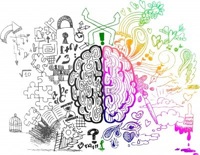Lateralization of brain function
Brain Lateralization of the human brain. It is divided into two hemispheres. The left brain controls functions that have to do with logic and reason, while the right brain controls functions involving creativity and emotion.
The longitudinal fissure separates the human brain into two distinct cerebral hemispheres, connected by the corpus callosum. The hemispheres exhibit strong, but not complete, bilateral symmetry in both structure and function. For example, structurally, the lateral sulcus generally is longer in the left hemisphere than in the right hemisphere, and functionally, Broca's area and Wernicke's area are present only in the left hemisphere in greater than 95% of the population.
Broad generalizations are often made in popular psychology about one side or the other having characteristic labels, such as "logical" for the left side or "creative" for the right. These labels need to be treated carefully; although a lateral dominance is measurable, both hemispheres contribute to both kinds of processes, and experimental evidence provides little support for correlating the structural differences between the sides with such broadly-defined functional differences.
The extent of any modularity, or specialization of brain function by area, remains under investigation. If a specific region of the brain, or even an entire hemisphere, is either injured or destroyed, its functions can sometimes be assumed by a neighboring region in the ipsilateral hemisphere or a corresponding region in the contralateral hemisphere, depending upon the area damaged and the patient's age. When injury interferes with pathways from one area to another, alternative (indirect) connections may develop to communicate information with detached areas, despite the inefficiencies.
Brain function lateralization is evident in the phenomena of right- or left-handedness[4] and of right or left ear preference,[5] but a person's preferred hand is not a clear indication of the location of brain function. Although 95% of right-handed people have left-hemisphere dominance for language, 18.8% of left-handed people have right-hemisphere dominance for language function. Additionally, 19.8% of the left-handed have bilateral language functions. Even within various language functions (e.g., semantics, syntax, prosody), degree (and even hemisphere) of dominance may differ.
Additionally, although some functions are lateralized, these are only a tendency. The trend across many individuals may also vary significantly as to how any specific function is implemented. The areas of exploration of this causal or effectual difference of a particular brain function include its gross anatomy, dendritic structure, and neurotransmitter distribution. The structural and chemical variance of a particular brain function, between the two hemispheres of one brain or between the same hemisphere of two different brains, is still being studied. Short of having undergone a hemispherectomy (removal of a cerebral hemisphere), no one is a "left-brain only" or "right-brain only" person.
Sex and gender differences are apparent in almost every aspect of neural anatomy and physiological psychology. This is definitely true with regards to lateralization differences between men and women. It is generally accepted that male brains are typically much more lateralized than female brains.
The major advantage to a greater lateralized brain is the ability for an individual to focus specific areas of the brain on distinct tasks. However, less lateralized brains, like the majority of women's, are better suited to "spread the work" and therefore engage many parts of the brain at once. Also, when multiple areas of the brain are engaged for similar tasks, the likelihood of recovering from traumatic brain injury is much higher.
See also
Quote
Brain-type series. The one physical uniformity of mortals is the brain and nervous system; nevertheless, there are three basic organizations of the brain mechanism: the one-, the two-, and the three-brained types. Urantians are of the two-brained type, somewhat more imaginative, adventurous, and philosophical than the one-brained mortals but somewhat less spiritual, ethical, and worshipful than the three-brained orders. These brain differences characterize even the prehuman animal existences.
From the two-hemisphere type of the Urantian cerebral cortex you can, by analogy, grasp something of the one-brained type. The third brain of the three-brained orders is best conceived as an evolvement of your lower or rudimentary form of brain, which is developed to the point where it functions chiefly in control of physical activities, leaving the two superior brains free for higher engagements: one for intellectual functions and the other for the spiritual-counterparting activities of the Thought Adjuster. (49:5.6, 7)
